
Grand Master Fra' Andrew Bertie

The fortified City of Valletta - A UNESCO World Heritage Site
When I was in Malta on the 7th February 2008 I noticed flags were flown at half mast including many flags displaying the Maltese Cross, the eight pointed flag of the Order of the Knights of Malta. I later found out that the flags were lowered in honour of Fra’ Andrew Bertie, a descendant of Britain’s royal Stuart family who was grand master of the Knights of Malta, who had died in Rome. His full title was His Most Eminent Highness, Fra' Andrew Bertie, Prince and Grand Master of the Sovereign Military Order of the Hospital of St. John of Jerusalem, of Rhodes and of Malta. In Latin his formal title is recited as "Dei gratia Sacrae Domus Hospitalis Sancti Johannis Hierosolymitani et militaris Ordinis Sancti Sepulchri Dominici magister humilis pauperumque Jesu Christi custos". (a part of this title commemorates the granting to the Grand Master d'Aubusson of the Mastership of the Order of the Holy Sepulchre by Pope Innocent VIII in 1489, which grant proved temporary).
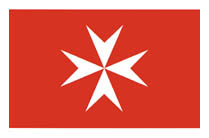
Enjoying the precedence of a Cardinal and therefore that of a Royal Prince as well as the dignity of Prince of the Holy Roman Empire (recognised later by Austria and Italy), and formerly a reigning Prince of Rhodes and then of Malta, the Grand Master is styled both Eminence and Highness, or Most Eminent Highness, and is internationally recognised as a Chief of State and sovereign honours are vested in him. Whilst little noticed in his native Britain he was the 78th man to hold the office and was the first Englishman to be elected the Order's leader since Hugh Revel in 1258, and the first non-Italian since the end of the 18th century. So who was this person and why did he and his organisation have such a grand eloquent title?
Elected for life, the grand master carries the title of prince, and the position is equal in rank to that of a cardinal. Fra Bertie’s father, James, was a foreign exchange dealer at the stock exchange in London. His mother, Lady Jean Crichton-Stuart, was a descendant of the Stuarts, the ruling family of Scotland from 1371 to 1603 and of England and Scotland from 1603 to 1714, with an 11-year interruption in the 17th century. Born in London in 1929, Fra Bertie joined the knights in 1956 and took his vows in 1981. He had also been a financial journalist and a language teacher. He was a fourth cousin of the Queen through James II and Sophie of Hanover.

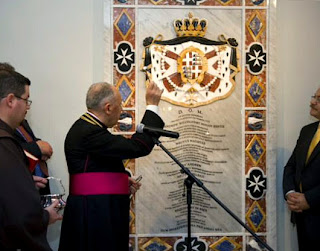
Unveiling of memorial to Fra'Andrew Bertie on Malta
With his friend Viscount Furness, Bertie developed an increasing interest in the Order of Malta, joining its British Association in 1956. Taking solemn religious vows in 1981, he moved to Rome, where he served on the Sovereign Council (the Order's governing body) for seven years. Nevertheless, it was a shock for so self-effacing a man, especially for one who was not an Italian, to find himself elected Grand Master in April 1988. In Italy, where the Order of Malta has a high profile, the election of an Englishman came as no less of a surprise.
The order traces its origins to the 11th century, when merchants from the Republic of Amalfi financed a hospital run by monks in Jerusalem to care for pilgrims to the Holy Land. It dates its founding, however, to 1099, when the monks took on a military role to protect the pilgrims. What is remarkable is that it is the only one of the Crusader Orders of Knights still extant as it had both a Hospitaller and Military role and the former function provides its raison d’etre today. Dedicated to caring for pilgrims and the poor and the sick, the Order emerged in Palestine in about 1100, during the Crusades, and took up arms to defend the Holy Land. It continued its war against Islam, first from Rhodes and then from Malta, whence it was evicted by Napoleon in 1798.
Since 1834 its headquarters has been the Palazzo Magistrale in Rome, which constitutes the world's smallest sovereign state; the Order exchanges ambassadors with many countries and issues its own passports. Membership is largely restricted to Catholics with proofs of nobility, although there is an increasing element from among the new elite. The higher officers are nearly always noblemen who have taken vows of poverty, chastity and obedience.
Today, the Order - officially known as the Sovereign Military Hospitaller Order of St John of Jerusalem, of Rhodes and of Malta - numbers about 12,500 knights, dames, chaplains and donats (members who are not knights).

Chapel of Grand Master Wignacourt, Rabat, Malta
The birth of the Order dates back to around 1048. Merchants from the ancient Marine Republic of Amalfi obtained from the Caliph of Egypt the authorisation to build a church, convent and hospital in Jerusalem, to care for pilgrims of any religious faith or race. The Order of St.John of Jerusalem - the monastic community that ran the hospital for the pilgrims in the Holy Land - became independent under the guidance of its founder, Blessed Gérard. when the crusaders captured Jerusalem in 1099, the hospital had been in operation for decades at least, perhaps centuries, caring for the sick and poor, Christian, Muslim, and Jew alike. It was ruled by a monk who was known as the Blessed Gerard who offered the Hospital’s services to the crusaders.
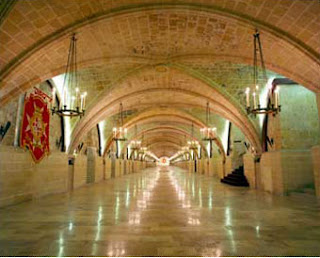
Sacra Infermeria (Holy Infirmary), Valetta
The hospital was operated under the Benedictine rule, but was able to free itself from their influence and establish themselves as a separate order. In 1113, Pope Paschal II issued a papal bull confirming the foundation of the Order of the Hospitallers. Gerard’s successor, Raymond du Puy was responsible for establishing the Military wing of the order in response to the creation of the Military Order of the Temple of Solomon, or the Knights Templar. The Military Order of the Hospitallers quickly grew into a major force in the Holy Land and, along with the Templars, provided the bulk of the forces for the defence of the Kingdom of Jerusalem garrisoning several fortresses on the frontiers of the kingdom. By 1168, they had become so powerful that they were capable of making and breaking treaties with neighbouring rulers without the consent of the King of Jerusalem. They were even responsible for forcing King Amalric into a premature invasion of Egypt for which they provided 500 brother knights and sergeants and 500 turcopoles or Syrian mercenaries.

A model of a Galley of the Knights
A bitter rivalry developed between the Hospitallers and Templars, once almost breaking out into a civil war. The two orders hated each other so much that they could only be convinced to go into battle side by side under the most dire of circumstances, such as the Battle of Hattin. But neither was hated more than by Saladin. After Hattin, Saladin paid 50 gold pieces each for every member of the two orders whom his followers had captured. He then had them all executed.
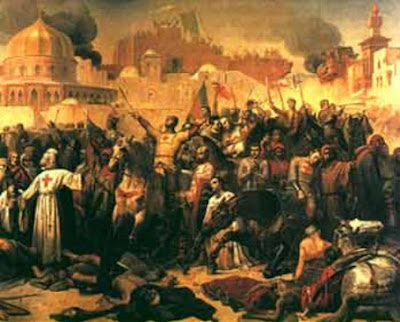
15th July 1099 - The Crusaders take Jerusalem and slaughter all Muslims & Jews in the city
After the loss of Jerusalem, and the hospital, the few remaining Hospitallers retreated to their frontier fortresses to wait for another crusade to retake the city. That came two years later when Kings Richard and Phillip arrived and laid siege to the city of Acre, an important port for reaching Jerusalem. The Hospitallers joined the siege, and after two years, the Christian forces captured the city. The Order established a new hospital and headquarters in Acre. The crusading army moved on toward Jerusalem but did not attack. Weary of the Crusade, Richard agreed on a deal for Saladin to keep the city as long as he allowed Christian pilgrims to visit it. However, the crusaders managed to capture a few other cities in Palestine.
With the Bull of 15 February 1113, Pope Paschal II approved the foundation of the Hospital and placed it under the aegis of the Holy See, granting it the right to freely elect its superiors without interference from other secular or religious authorities. By virtue of the Papal Bull, the Hospital became an Order exempt from the Church. All the Knights were religious, bound by the three monastic vows of poverty, chastity and obedience.

Grand Master Alof Wignacourt
The constitution of the Kingdom of Jerusalem regarding the crusades obliged the Order to take on the military defence of the sick, the pilgrims and the territories that the crusaders had conquered from the Moslems. The Order thus added the task of defending the faith to that of its Hospitaller mission. As time went on, the Order adopted the white eight-pointed Cross that is still its symbol today. These eight points represented the eight Langue or tongues of the order, the countries which provided recruits and support. Both in their original capital in Malta of Birgu (renamed Vittriosa “The Victorious” after the siege of 1565) and their new capital named after a previous Grand Master of Valletta you will find the Auberges or Inn’s of each Langue.
It has led a somewhat itinerant existence since its foundation as its base has wandered from Jerusalem to Rome. The crusader “Kingdom of Jerusalem” retrenched from Jerusalem to Acre after the failure of the 3rd Crusade and eventually they lost their foothold in the Holy Land when Acre fell in 1291.
1310 - Rhodes

When the last Christian stronghold in the Holy Land fell in 1291, the Order settled first in Cyprus and then, in 1310, led by Grand Master Fra' Foulques de Villaret, on the island of Rhodes. In fact the order took a number of the Dodecanese Islands by force from the Byzantine Emperor. Whilst the Latin and Byzantine Church split in the schism of 1054 (over disagreement about one word in the Nicean Creed!) the real bitterness between the churches relates to crusaders who came to the east to defend Christianity going on to spill Christian blood at the sack of Constantinople in 1204 and afterwards the Empire was divided up between the Venetians and Normans. The Byzantines would have seen the taking of Rhodes and the Dodecanese in the same light which is why the Knights of Malta are not well regarded by the Orthodox to this day.

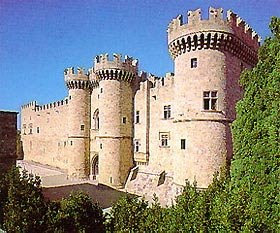
Palace of the Grand Masters, Rhodes.
From then, the defence of the Christian world required the organisation of a naval force. Thus the Order built a powerful fleet and sailed the Eastern Mediterranean, fighting many famous battles for the sake of Christendom - for example, the Crusades in Syria and Egypt. From its beginning, the independence from other nations granted by Pontifical deed, and the universally recognised right to maintain and deploy armed forces, constitute the grounds for the international sovereignty of the Order.
In the early 14th century the institutions of the Order and the knights who came to Rhodes from every corner of Europe were grouped according to the languages they spoke. There were initially seven groups of Langues (Tongues): Provence, Auvergne, France, Italy, Aragon (Navarre), England (with Scotland and Ireland) and Germany. In 1492 Castille and Portugal split off from the Langue of Aragon and constituted the eighth Langue. Each Langue included Priories or Grand Priories, Bailiwicks and Commanderies.

Grand Master's Throne, Rhodes
The Order was governed by its Grand Master (the Prince of Rhodes) and Council, minted its own money and maintained diplomatic relations with other States. The senior positions of the Order were given to representatives of different Langues. The seat of the Order, the Convent, was composed of religious of various nationalities. Today the Grand Masters Palace is still the centre of Rhodes town. It has suffered from a botched restoration by the Italians who occupied the Dodecanese from 1912 to 1943 and Mussolini had intended to use it as his summer palace.
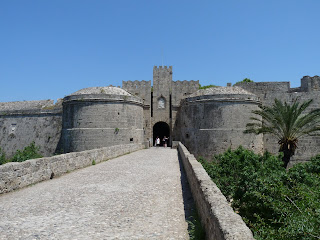
The walled City of Rhodes
The Siege of Rhodes

In 1522 Suleiman had just finished his conquest of the Balkans with a victory over Hungary at the terrible siege of Belgrade. Now, at last, he would destroy Rhodes. Suleiman sent a letter to the Grand Master urging his friendship (meaning submission or surrender), and with intimidation cited the Sultan's "...triumph over the Hungarian King, whom we have stripped of the strong fortress of Belgrade, after having wasted his territories with fire and sword, and carried away many of his people." The Grand Master replied courteously, but noted the Order's determination to always defend its homeland. The Sultan's reply was a declaration of war.
As in the great siege 42 years earlier, the villas were levelled, and all the population of Rhodes, together with all available food and forage, were brought within the walls of the city. The Knights abandoned their other islands such as Kos and Kalymnos to concentrate their forces to defend Rhodes. . Under the command of the outstanding Knight Commander Anthony Bosio, vessels were dispatched to Candia (Crete), Sicily, Naples and France for whatever additional supplies, armaments, and men could be obtained. For example, on Candia, Bosio was able to enlist 500 Cretan archers. The Sultan assembled his fleet some 700 ships of which more than 100 were fighting galleys. He gathered his army more than 200,000 trained troops and as many as 100,000 sappers (slaves who were used to burrow under fortifications and set explosives). The armada set sail, and arrived at Rhodes on June 26, 1522. After sailing past the city to strike terror into the hearts of the defenders, a deserted area was chosen for disembarkation. It took thirteen days to unload the army, the supplies, and the hundreds of cannon some capable of firing balls nine feet in circumference.

Head of Medusa, Roman mosaic orginally from Kos in the Grand Master's Palace, Rhodes
Defending Rhodes were some 500 Knights and their servants of arms, probably fewer than 1,500 mercenaries and perhaps 4,000 Rhodian troops. There were several thousand inhabitants of Rhodes who at the arrival of the Turks entered the walled city for protection. Most lacked military training, and many were women and children. They could, however, help rebuild the walls, carry water, deliver supplies, and pray. This was, indeed, a small force to oppose the gathered might of the greatest Empire in the history of Islam. In fact, the forces of the Order at this time were slightly smaller than in the previous siege of 1480. The city, however, was at its strongest, encompassed by a double wall with thirteen towers, numerous bastions and special fortifications, a deep wide ditch around all, and the entire area commanded by cannon positioned for both frontal assault and crossfire. Every possible preparation and precaution was taken. Even the Latin and Greek Archbishops were instructed to give sermons regarding the necessity and merit of courageous resistance. Public prayers were offered imploring victory for the champions of the Cross.
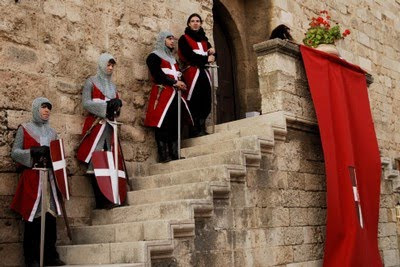
Knights guarding the entrance to the Grand Master's Palace, Rhodes
Almost immediately after disembarking, the bombardment began, and daily assaults were made against the fortified city attacks which failed and cost the Turks dearly due to the precision of the Rhodian cannoniers. So heavy were the losses that the invaders wanted to abandon the siege. However, after so many Turk defeats by the Order, this time the Sultan himself would command the siege. Suleiman came ashore on July 28th. His first act was to assemble his entire army, unarmed. Then he surrounded them with 15,000 of his personal guard, and because of their failures and their desire to disengage, he threatened to execute every tenth man. They prostrated themselves before him and begged mercy. There was never again talk of abandoning the field.

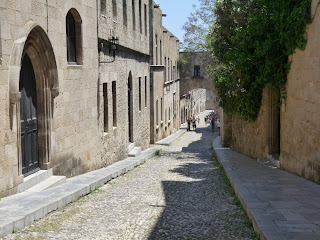
Street of the Knights, Rhodes
A violent, continuous, general bombardment now began. It is difficult to grasp the intensity of this siege. Once the cannonade began it rarely let up. The battle raged day and night for five months. During the day the walls would be battered into rubble, while engagements took place all around the city as thousands of Turks assaulted various fortified positions. Then, during the night, even under bombardment, the walls were rebuilt. Buildings throughout the city would be torn down and the stone used to rebuild the fortifications.
Typical of the warfare throughout this siege was the repeated heavy assault on the bulwark of the English Knights, which was several times mined. On September 4th, this wall was successfully mined and exploded, destroying 36 feet of the wall. The Turks soon gained control of this position and planted their standard. The Grand Master, praying prostrate before the altar of Saint Mary of Victory, hearing the explosion, rushed to the wall, led a furious fight to the top, and personally tore down the Turk banner. In the battle that continued for hours, more than two thousand Turks were killed. Rhodian musketeers along the wall shot down hundreds, while Knights in armour met steel with steel in hand-to-hand combat. In this engagement alone, forty-eight Knights fell. It was a heavy loss for the Turks and an irreplaceable loss for the Order, but again the Cross had held against the Crescent. A few days later a similar assault was launched against the bulwark of Italy, with almost identical results. Four days later, Mustapha Pasha with four battalions again assaulted the English bastion, and then the bastion of Spain. The fighting defies description, and this time the Turks lost more than three thousand brave Janissaries.
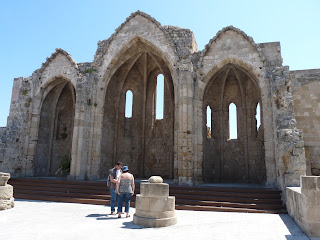
Ruins of Our Lady of the Bourg. This was once the largest Catholic church on Rhodes, built by the Knights to commemorate their defeat of the Turks in 1480. It was hit by a British bomb during the war. Only ruins of this church remain.
Then on September 24th, an all-out attack by tens of thousands was simultaneously launched on the bulwarks of Italy, Spain, England, Provence and Auvergne. Minute details of all these separate battles can be found in the Order's archives. The resistance, the heroism, almost exceeded human capabilities. Often only a few against hundreds in hand-to-hand combat. In addition, the Order's sharpshooters, even using the crude harquebus muskets of that era, were deadly. One French Knight, Francis Fornovi, shooting from the Tower of Saint George, killed more than 500 Turks during the siege. Thus the battle continued, almost without respite, from June into December. At one stage the Grand Master, dressed in his armour, slept for thirty-four successive nights behind the entrenchment on the Spanish bastion, ready to repulse the next attack. Eventually, nearly every principal bastion was beaten into rubble by the Turk cannon, only to find that the Order had dug new ditches and built new walls behind those that were destroyed. Moreover, while the courage and fanaticism of the Turk troops was astounding, the heroism of the Knights and the Rhodians who were fighting for their lives and for their women and children (who would be violated and put to horrible deaths if Islam prevailed) was even greater.
But the prolonged siege took its toll. By mid December, only a few Knights were still alive. Tens of thousands of Turks were dead. The stench of rotting bodies of men and animals hung all over the inland. Unsanitary conditions contributed to much disease. The suffering and dying of the thousands of wounded was almost unbearable. Finally, with winter approaching, the Sultan offered a truce. He had no idea how many Knights remained, and if a considerable number were still alive, and they continued to fight as they had done, the siege would be too costly for him to continue. Similarly, the Grand Master was faced with rebellion by the civilian Rhodians and Greek citizens, and demands by the clergy for a truce. With few Knights still able to resist, L'Isle Adam agreed to negotiations.

Stairs of the Grand Master's Palace, Rhodes
Filled with awe for the Knights, and in sharp contrast to the usual 3 days of pillage and killing, Suleiman was magnanimous. If the Order would surrender Rhodes, the Sultan promised that the churches would not be profaned, no children would be taken from their parents, all citizens would be allowed free exercise of their religion, any and all residents of Rhodes would be free to leave the island with the Knights, those who remained would pay no tribute for five years, the Knights would depart in their own galleys and be supplied by the Turks with additional ships if needed, the Order could embark with all its property relics, consecrated vessels, records, and the artillery on board its warships, and the Turk army would retire several miles from the city while this evacuation took place. Suleiman himself came into the city to salute the Grand Master and addressed him by the title of "Father." On the first day of January 1523, L'Isle Adam and his intrepid Knights put to sea on fifty ships loaded with the Order's property, together with all those who fought with the Order, and all Christians who wished to accompany them. Many years later in 1565 towards the end of his long reign Suleiman was to regret his magnanimity when one of the Knights who left Rhodes under honourable terms, Jean Parisot de la Valette, now Grand Master, led the Knights who defeated Suleiman’s forces at the Siege of Malta.
In the same year, 1523, a former Knight of the Order "who had laid aside the sword for the cowl and rosary" Cardinal Julio de Medici, was unanimously elected Pope Clement VII. In the procession following his election the great standard of the Order of Saint John was carried before the new Pontiff.
To see the Knight's City of Rhodes see;
http://daithaic.blogspot.com/2010/03/rhodes-town.html
1530 - Malta

Phillipe Villiers de L'Isle Adam being received by the Maltese at Mdina 1530

For seven years the Order had no home, taking only transitory residence in Sicily and Italy. In 1530 the knights were granted the small and barren islands of the Maltese archipelago, along with the city of Tripoli on the North African coast, by the Hapsburg Charles V, the Holy Roman Emperor and king of Spain. Charles knew the wisdom in having such a military force to protect his southern flanks from Suleiman and his allies, the corsairs of the Barbary Coast. Charles set rent for the island at the annual payment of a falcon.
It is hard to imagine who was more unhappy at the arrangement: the knights, dismayed over the barren, impoverished, and poorly-defended land; the nobles and peasants of Malta, resentful and suspicious of their new and foreign rulers, who did not bother even to learn their language; or the Ottomans and their allies the corsairs, who realized that the harbors of Malta were perfect for sheltering the troublesome knights, who now commanded the vital sea lanes between Sicily and North Africa.
In 1530 Grand Master L'Isle Adam was received by Malta's unhappy nobles at Mdina, an ancient walled city which at the time was the island's capital. The seafaring knights preferred to build their convent in the fishing village of Birgu. They slowly began fortifying the area around the Grand Harbor against the Ottoman attack that all knew was inevitable.
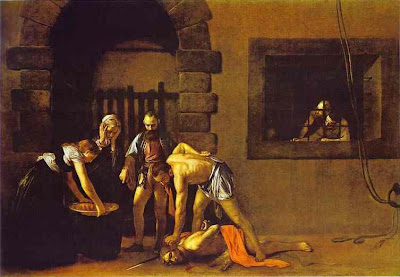
Caravaggio. The Beheading of St. John the Baptist. 1607-1608. Oil on canvas. Co-Cathedral of St. John, Valletta, Malta
It was established that the Order should remain neutral in any war between Christian nations. In 1565 the Knights, led by Grand Master Fra' Jean de la Vallette (after whom the capital of Malta, Valletta, was named), defended the island for more than three months during the Great Siege by the Turks. In gratitude for the defence and defeat of the Turks after the Great Siege of Malta Christian Europe poured funds into the island and a new purpose built defensive capital of Valletta was built under the supervision of a military engineer sent by the Pope. . Today, the city they left behind is the greatest example of a fortified medieval city and a Unesco World Heritage site.
The Siege of Malta
The year is 1565. On the island of Malta, 600 Knights of St. John, commanding a force of some 8000 men, prepare to defend their island fortress from attack. These same Catholic Knights had been driven from their previous stronghold, the Isle of Rhodes, in 1522, by the Ottoman Turks. Under Suleiman the Magnificent, the Moslems were pressing hard across Arabia, Syria, Iraq, into Egypt and northern Africa, and had established a strong foothold on the north coast of the Black Sea, the gateway to all of Europe itself. In 1526, the Hungarians had been defeated at the Battle of Mohacs, and only the Austrian Habsburgs now stood in the way of the Moslem advance. Vienna came under attack in 1529, but the Moslems were unable to take the capital, and their over-extended campaign failed.
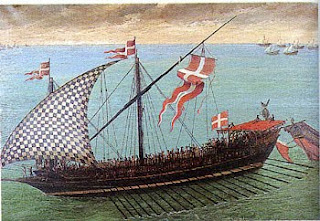
Galley of the Knights
Now, the Turks had raised a fleet of 181 ships, carrying some 30,000 soldiers, and Malta was the prize they sought. Their goal was to plunder and sweep all the ships of Christian Europe from the Mediterranean. Then, in control of the sea lanes and trade routes, with their naval and economic power supreme, all of Europe would be set to fall before them.
The Turkish fleet appeared off the coast of Malta, and laid siege to the island. All through the summer of 1565 the contest for Malta raged. In the end, the Knights of St. John (Knights of Malta) were victorious, and the Turks were forced to withdraw in defeat. It did not, however, end the threat from the Ottoman Turks.

The 3 Cities held by the Knights in the siege of Malta - seen from Valetta which was built after the siege
This was psychological warfare at its most brutal; a message sent by the Turkish Muslim commander whose invading army had just vanquished the small outpost of Fort St Elmo - a thousand yards distant across the water. Now the target was the one remaining fort on the harbour front where the beleaguered, outnumbered and overwhelmed Christians were still holding out: the Fort St Angelo. The Turkish commander wished its defenders to know that they would be next, that a horrible death was the only outcome of continued resistance.

Fort St. Angelo - Now reoccupied by the Knights under agreement with the Government of Malta
But the commander had not counted on the mettle of his enemy - the Knights of St John. Nor on the determination of their leader Grand Master Jean Parisot de la Valette, who vowed that the fort would not be taken while one last Christian lived in Malta. On news of the grotesque discovery of the headless knights - many of them his personal friends - Grand Master Valette quickly ordered that captured Turks imprisoned deep in the vaulted dungeons of the fort be taken from their cells, and beheaded one by one.
Then he returned a communiqué of his own: the heads of his Turkish captives were fired from his most powerful cannon direct into the Muslim lines. There would be no negotiation, no compromise, no surrender, and no retreat. We Christians, the Grand Master was saying, will fight to the death and take you with us. The Siege of Malta in 1565 was a clash of unimaginable brutality, one of the bloodiest - yet most overlooked - battles ever fought. It was also an event that determined the course of history, for at stake was the very survival of Christianity.
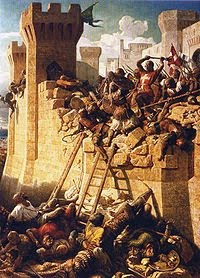
If vitally strategic Malta fell, the Muslim Ottoman Empire would soon dominate the Mediterranean. Even Rome would be in peril. The Muslims had hundreds of ships and an army tens of thousands strong. The Christians were a ragtag bunch of just a few hundred hard-bitten knights and some local peasant soldiers with a few thousand Spanish infantry. Malta looked doomed. That the Hospitaller Knights of St John existed at all was a minor miracle. They were a medieval relic, an order established originally to look after ailing pilgrims to the Holy Lands during the Crusades 300 year’s earlier - other orders of the Crusades, such as the Knights Templar, had been extinct for two-and-a-half centuries.
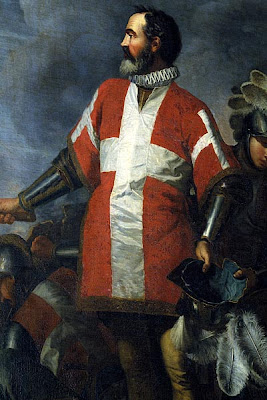
Grand Master Jean Parisot de la Valette
They came from countries all over Europe: Germany, Portugal, France, and Spain. All that united them was a burning desire to defend Christendom against what they perceived as the ever-encroaching tide of Islam. Yet by the 16th century, an age of the increasing power of nation states, these trans-national zealots were viewed as an embarrassing anachronism by much of Europe. Already the Turks had forced them from their earlier home, the island of Rhodes. Now the knights had moved to Malta - and were threatened once more.
Suleiman controlled the greatest fighting force in the world. Before him lay an armada of 200 ships ready to sail, an army of 40,000 troops on board. He planned to wipe the barren rock of Malta and the Knights of St John from the map. These knights lived by raiding and disrupting his Ottoman shipping routes. The last straw had been their capture of the prized ship of his powerful courtier the Chief Black Eunuch.


Grand Master's Palace, Valetta
The Sultan did not expect undue trouble exacting his revenge. A mere 700 knights stood in his way. Such a rabble would be quickly cleared. The Turkish fleet headed across the Mediterranean in March 1565. Aboard the ships were the elite Janissary shock-troops - the "Invincible Ones" - who had carried Islam across Europe with the slashing blades of their scimitars. In late May 1565, the invasion force arrived at the island. The knights awaiting them enjoyed good intelligence of their plans and had asked for assistance from the Christian armies of European nations. Every kingdom spurned their request - other than Sicily, which said that if the knights held out, help would eventually come.
They first attacked Fort St. Elmo at the head of the rocky peninsular which is today the City of Valletta. Each time they were met by the ragged and diminishing band of defenders, fighting with pikes and battle-axes, firing muskets and dropping blocks of stone, throwing fire-hoops that set ablaze the flowing robes of the Muslims and sent them burning and plummeting to their deaths. The fire-hoops - covered in flax and cotton, dipped in brandy and coated with pitch and saltpetre - were the knights' own invention. Dropped blazing over the bastion walls, they could engulf three Turks at a time. For 30 days, cut off and doomed, the soldiers of St Elmo prevailed. The Turkish general had expected the fort to fall within three. Late at night on Friday June 22, 1565, the few hundred survivors from an original garrison of 1,500, sang hymns, offered up prayers, defiantly tolled their chapel bell and prepared to meet their end the next day.

Gate to the City of Birgu, Malta (renamed Vittriosa “The Victorious” after the siege of 1565)
Those unable to stand were placed in chairs behind the shattered ramparts, crouching low with their pikes and swords to await the final assault. When it came, and the entire Turkish army descended as a howling mass, the handful of Christians still managed to fight for several hours. Eventually the Ottomans took their prize. The crescent banners of the Grand Turk flew above the ruins, the heads of the knights were raised on spikes, and the crucified bodies of their officers were floated across to Fort St Angelo on the far side of the harbour. The Turks had lost time and up to 8,000 of their crack troops.

Auberge de Castille y Leon, Valletta
Summer heat was rising, disease and dysentery spread throughout the Muslim camp, and the dead lay piled around the blackened remnants of the seized fort. But Grand Master Valette was not about to quit. Scenes of heroism and horror abounded in the terrible days that followed. There were extraordinary characters: Fra Roberto, the priest who fought on the battlements with a sword in one hand and a cross in the other; the two English "gentlemen adventurers" who arrived belatedly from Rome to take part in the action; Valette himself, who stood unyielding in the breach and used a spear to battle hand-to-hand against the foe.
Others had led desperate sallies against the Ottoman, harrying their labour corps, sniping at commanders, spiking their guns. But the enemy, too, had their brave and vivid figures. Among them was Dragut, the most feared corsair of his day, whose skill and dash had served the Sultan well. A cannonball splinter did for him. Yet the siege continued, the target now St Angelo, the final and fortified enclave of the knights on the southern side of Grand Harbour.

Auberge d'Auvergne et Provence, Valletta
The Turks tried every twist and tactic in their military manual. They tunnelled beneath the Christian defences to bury gunpowder and blow the knights to bits. The Maltese responded with their own mines to blow up the tunnels and there were terrible skirmishes below ground. Next the Turks drew up siege engines, giant towers designed to pour their infantry direct on to the battlements. The knights removed stones at the base of the battlement walls so that they could run out cannon through the openings they had created, and blast the siege engines apart.

On several occasions those walls were breached, the Turks rushing through eager to slaughter all in their path. Triumph seemed at hand but they found too late that the knights had improvised an ambush, creating a killing zone into which they were funnelled and slaughtered. Success for the Turks was slipping away. The furnace temperatures of July and August sapped morale and strength; the sense of failure clung as pervasively as the surrounding stench of death. The Turks' commander, Mustapha Pasha, marched inland to take the walled city of Mdina, only to withdraw when scouts informed him of its substantial and well-armed garrison. It was a trick. Mdina was largely undefended, its governor ordering women and children to don helmets carry pikes and patrol the walls. Frantic, with casualties mounting and autumn storms looming, the Turks rolled a giant bomb - a fiendish barrel-shaped object packed with gunpowder and musket balls - into the Christian positions.
The knights promptly rolled it back and it blew a devastating hole in the massed and waiting Muslim ranks. It rained. Believing the gunpowder of the knights to be damp, their muskets and cannon useless, Mustapha Pasha again sent his troops forward. They were met by a hail of not only crossbow bolts but gunfire, for Valette had anticipated such a moment, setting aside stores of dry powder. Finally, relief reached the knights in the form of a small army from Sicily. Believing the enemy reinforcements too weak to be of any consequence, Mustapha Pasha angrily ordered his troops - who had bolted on hearing of the new arrivals - to turn back and march towards them. It was the last of his many grave blunders.
The cavalry of the relief force charged, then the infantry, tearing into the Turkish centre, putting it to flight. Rout turned to bloodbath. The once-proud Ottoman force scrambled in disarray for its ships, pursued across the island, cut down and picked off at every step. Thousands died and the waters of St Paul's Bay ran red. Of the 40,000 troops that had set sail in the spring from Constantinople, only some ten thousand made it home. Behind them they had left a scene of utter devastation. Almost the entire garrison commanded by Jean Parisot de Valette - after whom the city of Valletta is named - had perished. Now, after 112 days of siege, the ragged handful of survivors limped through the blitzed wreckage of their lines.
Malta was saved, for Europe and Christianity. The Knights of St John had won. To this day Victory Day, 8 September, is a national holiday in Malta. It is locally known as il-Vitorja (the Victory) and il-Bambina (Baby Mary) and it celebrates not as many think the victory in World War 11 but the victory of the Great Siege by the Knights of St. John against the Turks of 1565.

Armoury, Grand Master's Palace, Valletta.
1571 - The Battle of Lepanto
The fleet of the Order, then one of the most powerful in the Mediterranean, contributed to the ultimate destruction of the Ottoman naval power in the Battle of Lepanto in 1571. When news of the victory reached Europe, church bells rang out in cities all across the continent. The Battle of Lepanto was a decisive victory, with only 40 of the over 300 Moslem ships surviving the engagement. The Turkish force of some 75,000 men was in ruins.

Battle of Lepanto
The battle, although a great victory for Catholic Europe, did not end the threat of invasion, or completely break the power of the Ottoman Turks. More naval and land battles would follow in the years to come, and Vienna itself would come under attack again, and yet again.
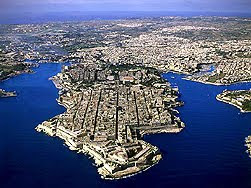
Valletta on Mount Sciberras with St. Elmo Fort at its seaward tip
After the Great Siege, a new and more heavily fortified capital was built on Sciberras, a peninsula overlooking the Grand Harbor. The city was called Valletta, after the Grand Master who led the island's defenders against the Ottoman attack. The knights continued their traditions of maintaining one of Europe's finest hospitals, of raiding enemy (Muslim) shipping, trading in slaves, and, of course, drinking and debauching. Afterwards the power of the Knights grew until by the 17th Century the Grand Master was styled “King of Malta” and wore the closed or “magisterial” crown. He had acquired all the attributes of sovereign, addressing kings as "Cousin". He still wears an extraordinary hat of office - an inverted fluted cone - that is as distinctive in its own way as that of a Venetian Doge.
Valletta's Sacra Infermeria

The extensive edifice of the Sacra Infermeria (Holy Infirmary) occupies a large site which overlooks the Grand Harbour, very near Fort St. Elmo. This hospital, one of the first buildings of Valletta, started to function in 1574 under Grand Master Jean de la Cassiere. Originally, it consisted of a large ward. Under the rule of Grand Master Nicholas Cottoner (1663 - 80), the hall was enlarged; and in 1712 Grand Master Perellos commissioned a new building alongside Merchants Street, which included a chapel and a pharmacy.
Valletta's Sacra Infermeria was the best-equipped hospital of the Order. In its day, it counted amongst the finest hospitals in Europe. The Infermeria had six wards; the largest measured 161 metres and is still the longest and one of the most impressive rooms in Europe. The infirmary provided about 900 beds for male patients who included knights, soldiers, sailors and foreigners. Maltese patients and slaves were accommodated in another large hall below the Main Ward. In 1676, a school of anatomy and surgery was set up in the building.
The administration of the Sacra Infermeria was entrusted to knights of the French Langue, under the headship of the Grand Hospitaller. When the Knights were forced to leave the Island in 1798, Napoleons’ troops used the hospital for their own personnel. The British, who took over Malta’s government in 1800, renamed the Infirmary ‘Station Hospital’, and used it as such until the end of the First World War.
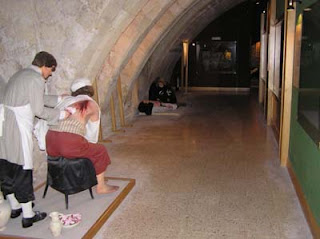
Tending the wounded

Sacra Infermeria
The Sacra Infermeria was a huge contrast to the often squalid hospitals of the day. Because healing was part of their oath the Knights ensured it was spacious and airy and kept scrupulously clean even though the importance of hygiene and the existence of germs was not understood at the time. Like Hippocrates they believed in a holistic approach to healing with spiritual counselling and hearty food often served by the Knights themselves as part of their vow to minister to the sick. Food was served from silver platters rather than the wooden platters used at the time and whilst the Knights realised that these could be cleaned better it has since been discovered that silver itself has natural antiseptic properties.
1798 - In exile
Their Mediterranean stronghold of Malta was captured by Napoleon in 1798 during his expedition to Egypt. As a ruse, Napoleon asked for safe harbor to resupply his ships, and then turned against his hosts once safely inside Valletta. Grand Master Ferdinand von Hompesch zu Bolheim failed to anticipate or prepare for this threat, provided no effective leadership, and readily capitulated to Napoleon, arguing that the order's charter prohibited fighting against Christians. In 1799, in disgrace and under pressure from the Austrian court, he resigned his office and retreated into obscurity.The Maltese boxed in the French for two years in Valletta and the Three Cities until the British Fleet accepted their surrender.
The knights were now dispersed, though the order continued to exist in a diminished form and negotiated with European governments for a return to power. The Russian Emperor, Paul I, gave the largest number of knights shelter in St. Petersburg, an action which gave rise to the Russian tradition of the Knights Hospitaller and the Order's recognition among the Russian Imperial Orders. The refugee knights in St Petersburg proceeded to elect Tsar Paul as their Grand Master – a rival to Grand Master von Hompesch until the latter's abdication left Paul as the sole Grand Master. As Grand Master Paul I created, in addition to the Roman Catholic Grand Priory, a "Russian Grand Priory" of no less than 118 Commanderies, dwarfing the rest of the Order and open to all Christians. Paul's election as Grand Master was, however, never ratified under Roman Catholic canon law, and he was the de facto rather than de jure Grand Master of the Order.
By the early 1800s, the order had been severely weakened by the loss of its priories throughout Europe. Only 10% of the order's income came from traditional sources in Europe, with the remaining 90% being generated by the Russian Grand Priory until 1810. This was partly reflected in the government of the Order being under Lieutenants, rather than Grand Masters, in the period 1805 to 1879, when Pope Leo XIII restored a Grand Master to the order. This signalled the renewal of the order's fortunes as a humanitarian and religious organization. Hospital work, the original work of the order, became once again its main concern.

Insignia of The Order
Although the sovereign rights of the Order in the island of Malta had been reaffirmed by the Treaty of Amiens (1802) and the Congress of Vienna (1815), the Order has never been able to return to Malta. When the British landed on the island in 1800 they found themselves de facto rulers of Malta and it became the key to the British Navy’s control of the Mediterranean and the passage to India when the Suez Canal opened.
To see the Knight's City of Valletta see;
http://daithaic.blogspot.com/2008/05/valletta-and-grand-harbour.html
1834 - Rome
After having temporarily resided in Messina, Catania and Ferrara, in 1834 the Order settled definitively in Rome, where it owns, with extraterritoriality status, the Magistral Palace in Via Condotti 68 and the Magistral Villa on the Aventine Hill.
The 20th and 21st Century
The original Hospitaller mission became once again the main activity of the Order, growing ever stronger during the last century, most especially because of the contribution of the activities carried out by the Grand Priories and National Associations in so many countries around the world. Large-scale Hospitaller and charitable activities were carried out during World Wars I and II under Grand Master Fra' Ludovico Chigi Albani della Rovere (1931-1951).Under the Grand Masters Fra’ Angelus de Mojana di Cologna (1962-1988) and Fra' Andrew Bertie (1988-2008) the Order was reformed to adopt a more international structure emphasising its original mission of caring.

Coat of Arms of the Knights of Malta
The Order has recently returned to Malta, after signing an agreement with the Maltese Government which granted the Order the exclusive use of Fort St. Angelo at overlooking the Grand Harbour for a term of 99 years. Located in the town of Birgu, the Fort belonged to the Knights from 1530 until the island was occupied by Napoleon in 1798. Today, after restoration, the Fort hosts historical and cultural activities related to the Order of Malta.
So by any standards after 900 years this Order is a remarkable survivor in the modern world, the only tangible link with the Crusades which for good or bad have defined the relationship between the 3 religions of Christianity, Judaism and Islam and also between Latin and Eastern Christians.
The Order combines an aristocratic membership with modern humanitarian activities. In Catholic Europe it is the last bastion of the old establishment. King Juan Carlos was President of its Spanish Association before he became king, while the Austrian Association contains a score of Habsburg archdukes. Its hospitaller activities - funding and administering hospitals, providing ambulance brigades and sending supplies - range from Peru to Pakistan, from California to Russia. There is also a worldwide relief service, Malteser International. The Order specialises in helping victims of armed conflict or natural disaster, providing medical assistance, caring for refugees and distributing medicine and basic equipment for survival.

Its members are supported by 80,000 permanent volunteers, who are backed by a qualified staff that consists of more than 13,000 doctors, nurses, auxiliaries and other assistants.
Fra' Andrew's term of office proved highly successful. He spoke five languages (and had a working knowledge of half a dozen more), and he increased the Order's membership, bringing a fresh approach to its humanitarian activities and extending aid to hitherto inaccessible regions.
The Order's diplomatic missions, offering assistance during natural disasters or armed conflict, doubled from 49 to 100. Fra' Andrew established conferences at which members of the Order were invited to contribute to its work, were encouraged to commit themselves to the spiritual aspect of its mission to the sick and the poor, and were urged to live according to Christian principles. Above all, he wanted the knights, even those not in vows, to see their calling as a religious vocation.
On Malta, where he loved to spend holidays (Both he and his mother had holiday homes and citrus groves on Malta at Attard), he organised judo classes for children, teaching them himself (he was a judo black belt). He enjoyed great support from his younger brother Peregrine, and was delighted when he became president of the British Association.
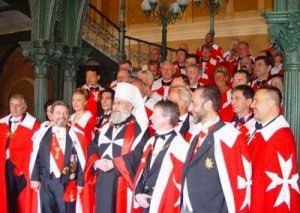
Knights with an Orthodox Metropolitan
Characteristically, the Grand Master's last official pronouncement, in January this year, was very much to the point. In an address to the ambassadors accredited to the Sovereign Military Order, he warned of harmful and unfounded rumours that the knights were involved in anti-Islamic activities in countries where, in reality, they were engaged in humanitarian work. Rumours of this sort, he told the ambassadors, were placing the lives of the Order's volunteer carers in grave danger.
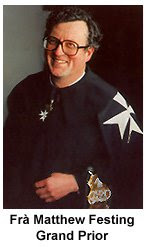
Today this venerable institution faces new challenges. Remarkably, they have elected another Englishman, Fra' Matthew Festing, 58, to become the 79th Grand Master of the Sovereign Military Hospitaller Order of St John of Jerusalem of Rhodes and of Malta. It needs to revamp and redefine itself and in particular its archaic structure and insistence on aristocratic antecedents is a major barrier to growth and development, particularly in areas such as the United States where it needs to win supporters and funds. Its aristocratic nature was outdated when (the then) General Napoleon landed on Malta in 1798 and has not become more relevant since. However given its remarkable history and capacity for regeneration who would suggest that the Sovereign Military Hospitaller Order of St John of Jerusalem of Rhodes and of Malta does not have 900 years of history in front of it?
http://www.orderofmalta.org/

Magistral Palace in Via Condotti, Rome

